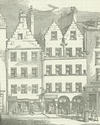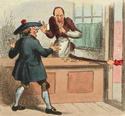 In the 17th and 18th centuries, as in the past, most people in Glasgow would buy their goods from market stalls and more specialised items at fairs and from itinerant pedlars. Some stalls became permanent and could be locked up at night. They were known in Scotland as luckenbooths and were to be found in rows in such places in Glasgow as the High Street and the Saltmarket. Gradually more permanent shops, mostly selling luxury goods, began to be opened on the ground floor of people’s houses. In Glasgow, Argyle Street running westwards from the Cross had become a shopping street by 1712 when the highest rent for a shop was £5 a year and the lowest twelve shillings.
In the 17th and 18th centuries, as in the past, most people in Glasgow would buy their goods from market stalls and more specialised items at fairs and from itinerant pedlars. Some stalls became permanent and could be locked up at night. They were known in Scotland as luckenbooths and were to be found in rows in such places in Glasgow as the High Street and the Saltmarket. Gradually more permanent shops, mostly selling luxury goods, began to be opened on the ground floor of people’s houses. In Glasgow, Argyle Street running westwards from the Cross had become a shopping street by 1712 when the highest rent for a shop was £5 a year and the lowest twelve shillings.
 The growing prosperity of the city during the 18th century encouraged the opening of more and more shops and coffee houses to cater for the needs of the merchants with their grand new homes. In most of these early shops there was no distinction between wholesale and retail trade, and in clothing and furniture between a shop and a workshop. Many shopkeepers were willing to display their goods in the homes of wealthy clients and deliver bulk orders. Apart from sugar, spices, tea, coffee and other luxuries, household necessities continued to be purchased at markets or directly from manufacturers, such as bakers and brewers. The prices of basic foodstuffs were controlled by the Corporation, which also inspected weights and measures and licensed retailers of spirits.
The growing prosperity of the city during the 18th century encouraged the opening of more and more shops and coffee houses to cater for the needs of the merchants with their grand new homes. In most of these early shops there was no distinction between wholesale and retail trade, and in clothing and furniture between a shop and a workshop. Many shopkeepers were willing to display their goods in the homes of wealthy clients and deliver bulk orders. Apart from sugar, spices, tea, coffee and other luxuries, household necessities continued to be purchased at markets or directly from manufacturers, such as bakers and brewers. The prices of basic foodstuffs were controlled by the Corporation, which also inspected weights and measures and licensed retailers of spirits.